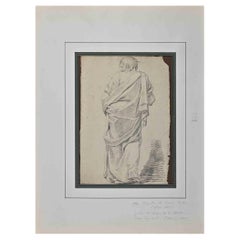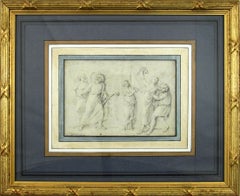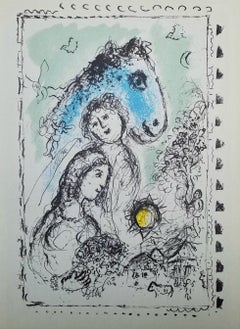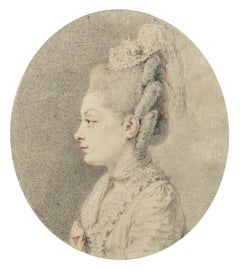Augustin de Saint-Aubin Art
French, 1736-1807
Augustin de Saint-Aubin was born on January 3rd 1736 into a family of artists: his father Gabriel-Germain (1696-1756) was the King's embroiderer and his six surviving siblings (Charles-Germain (born in 1721), Gabriel-Jacques (1724), Catherine-Louise (1727), Louis-Michel (1731), Athanase (1734) and Agathe (1739)) were also artists. The eldest of the boys, Charles-Germain, became a draughtsman and embroiderer like his father, Gabriel-Jacques? is considered one of the most brilliant draughtsmen of the 18th century, Louis-Michel became a painter at the Sèvres porcelain manufactory and Athanase an actor, while his two sisters were also talented draughtswomen.
During his lifetime Augustin de Saint-Aubin's fame as a draughtsman and engraver far out-shadowed that of his twelve-year-old elder brother Gabriel, but the Goncourt brothers initiated research into the French 18th century art sphere which gave back its pre-eminence to Gabriel’s works.
Initially trained by his brother Gabriel, the young Augustin continued his apprenticeship with the engraver Etienne Fessard (1714 - 1777) and very quickly set his sights on becoming an engraver.
Accepted to the Académie Royale in 1771, he was never admitted because he did not submit his reception piece. This did not prevent him from having a successful and very prolific career as an engraver, since his output is estimated at more than 1,300 engravings.
Portraits - whether drawn or engraved - constitute the best part of his work and also the most sought-after, particularly by the Goncourt brothers, who owned several portraits among the dozen or so drawings of Augustin de Saint-Aubin they had collected/in their collection.(Biography provided by Stephane Renard Fine Art)
1
to
3
1
1
3
3
Overall Height
to
Overall Width
to
2
1
2
1
1
1
1
2
1
2
3
6,827
3,114
2,517
1,217
2
1
1
1
Artist: Augustin de Saint-Aubin
Portrait of a Lady, Drawing Signed and Dated by Augustin de Saint-Aubin
By Augustin de Saint-Aubin
Located in PARIS, FR
This drawing full of freshness presents us with the profile of an elegant lady, drawn by Augustin de Saint-Aubin on a beautiful summer day in 1776, during the early months of Louis X...
Category
1770s Old Masters Augustin de Saint-Aubin Art
Materials
Pastel, Pencil
Figure of Man - Original Pencil Drawing by Augustin de Saint-Aubin- 19th Century
By Augustin de Saint-Aubin
Located in Roma, IT
Figure of Man is an Original Pencil Drawing realized by Augustin de Saint-Aubin (1736-1807).
Good condition included a green and white cardboard passpartout (65x48 cm).
No signatur...
Category
Late 18th Century Modern Augustin de Saint-Aubin Art
Materials
Pencil
Young Lovers - Original Lithograph by Augustin de Saint-Aubin- 19th Century
By Augustin de Saint-Aubin
Located in Roma, IT
Young Lovers is an original artwork, lithograph, "d'après" after an etching of Augustin de Saint-Aubin after a Fragonard's drawing. Is not signed and dated...
Category
19th Century Modern Augustin de Saint-Aubin Art
Materials
Lithograph
Related Items
François-Édouard Picot (French 1786-1868) Greek Comedy Play 19th Century Drawing
By François-Édouard Picot
Located in Meinisberg, CH
François-Édouard Picot
(French, 1786 – 1868)
Ancient Greek Comedy Play
• Pencil Drawing on laid paper behind decorative matting, visible image, ca. 10.5 x 15.5 cm
• Modern Glased frame, ca. 27 x 33 cm
• Signed "Picot fecit" lower left
• As we photographed through glass, there are reflections in the images
Worldwide shipping is complimentary - There are no charges for handling & delivery
Here we have the somewhat unusual, yet typical subject matter François-Édouard Picot was interested in depicting. Shown is a scene from an ancient Greek comedy play. The previous owner has noted on the back, that this image was copied from an ancient Greek stone relief.
François-Édouard Picot was born on the 10th of October in 1786 in Paris, France. He studied with various masters and became well known for his historical and mythological subjects. In 1812 he won the second prize in the Prix de Rome competition and after that success, went on to exhibit at the Paris Salon, where in the year 1819 he won a first-class medal for his neoclassical L'Amour et Psyché, which today hangs in the Louvre in Paris. He regularly exhibited his work in the salon up to 1839. He taught several young great artists at his elitist studio and was known for accepting only very few students, which included William Bouguereau, Gustave Moreau, Cabanel and Paul Seignac...
Category
Early 19th Century Naturalistic Augustin de Saint-Aubin Art
Materials
Laid Paper, Pencil
Free Shipping
H 10.63 in W 13 in D 1.19 in
Cheval Bleu au Couple (Blue Horse with Couple) /// Modern Marc Chagall Post-War
By Marc Chagall
Located in Saint Augustine, FL
Artist: Marc Chagall (Russian-French, 1887-1985)
Title: "Cheval Bleu au Couple (Blue Horse with Couple)"
Portfolio: Derrière Le Miroir: Hommage à Aimé et Marguerite Maeght (No. 250)
...
Category
1980s Modern Augustin de Saint-Aubin Art
Materials
Lithograph
Costume drawings for ‘Ambassadeur de Siam’ and ‘La Sultana Reine’
Located in Amsterdam, NL
Joseph-Marie Vien (1716-1809)
‘Ambassadeur de Siam’ and ‘La Sultana Reine’
Both titled lower centre, the drawing of the ambassador inscribed with colours intended for the prints, e...
Category
Mid-18th Century Old Masters Augustin de Saint-Aubin Art
Materials
Paper, Pencil
Free Shipping
H 9.26 in W 6.89 in D 1.19 in
Some People Together
By Karel Appel
Located in New York, NY
Some People Together, 1974
Hand-signed and dated in pencil
Color lithograph and screenprint
Sheet 22 x 29 3/4 inches; 559 x 756 mm.
Edition 110
Category
1970s Modern Augustin de Saint-Aubin Art
Materials
Lithograph, Screen
Vintage David Hockney poster Six Fairy Tales from the Brothers Grimm
By David Hockney
Located in New York, NY
This charming vintage poster commemorated the publication of David Hockney's Six Fairy Tales from the Brothers Grimm. The poster advertises a miniature ...
Category
1970s Modern Augustin de Saint-Aubin Art
Materials
Lithograph, Offset
Le French CanCan from La Ville
By Fernand Léger
Located in New York, NY
This lithograph by Fernand Leger is from the portfolio entitled "La Ville" (The City) which consists of 29 lithographs featuring scenes of people, life and emotions of Paris. The art...
Category
1950s Modern Augustin de Saint-Aubin Art
Materials
Lithograph
Memnon - after Georges Braque - Lithograph - 1988 - Figurative Print
By (after) Georges Braque
Located in Sint-Truiden, BE
Color lithograph after a gouache by Georges Braque from the edition of 398 published by Armand & Georges Israel in 1988. Printed signature.
Artwork entirely made in France: from th...
Category
1980s Modern Augustin de Saint-Aubin Art
Materials
Lithograph
Mon Colonel
By Auguste Chabaud
Located in London, GB
'Mon Colonel', pencil and crayon on paper, by noted French artist, Auguste Chabaud (circa 1914-1918). A delightfully simple drawing of a French Army colonel in profile along with clo...
Category
1910s Modern Augustin de Saint-Aubin Art
Materials
Paper, Crayon, Pencil
Boissier, Portrait of a Young Man, 1802, Pastel signed and dated
By Boissier
Located in Paris, FR
Boissier (painter and portraitist active at the end of the 18th century)
Portrait of a young man
Signed and dated "Boissier f(ecit) 1802" on the lower right
Pastel on paper transfere...
Category
Early 1800s Old Masters Augustin de Saint-Aubin Art
Materials
Pastel
Boston Abstract Expressionist Hyman Bloom Original Pencil Drawing Martin Sumers
By Hyman Bloom
Located in Surfside, FL
This is a unique artwork. This is an original Hyman Bloom drawing of fellow artist and his very good friend Martin Sumers.I believe this was drawn at the “variations of a theme” at Sumers gallery in NYC. The last two photos show a poster and a card from their shows. it is not included in this listing, it is just for provenance.
Provenance: Acquired from the Sumers estate collection.
Hyman Bloom (March 29, 1913 – August 26, 2009) was a Latvian-born American painter. His work was influenced by his Jewish heritage and Eastern religions as well as by artists including Altdorfer, Grünewald, Caravaggio, Rembrandt, Blake, Bresdin, James Ensor and Chaim Soutine. He first came to prominence when his work was included in the 1942 Museum of Modern Art exhibition "Americans 1942 -- 18 Artists from 9 States". MoMA purchased 2 paintings from the exhibition and Time magazine singled him out as a "striking discovery" in their exhibition review.
His work was selected for both the 1948 and 1950 Venice Biennale exhibitions and his 1954 retrospective traveled from Boston's Institute of Contemporary Art to the Albright Gallery and the de Young Museum before closing out at The Whitney Museum of American Art in 1955. In a 1954 interview with Yale art professor Bernard Chaet, Willem de Kooning indicated that he and Jackson Pollock both considered Bloom to be “America’s first abstract expressionist”, a label that Bloom would disavow. Starting in the mid 1950s his work began to shift more towards works on paper and he exclusively focused on drawing throughout the 1960s, returning to painting in 1971. He continued both drawing and painting until his death in 2009 at the age of 9
Hyman Bloom (né Melamed) was born into an orthodox Jewish family in the tiny Jewish village of Brunavišķi in what is now Latvia, then part of the Russian Empire
At a young age Bloom planned to become a rabbi, but his family could not find a suitable teacher. In the eighth grade he received a scholarship to a program for gifted high school students at the Museum of Fine Arts. He attended the Boston High School of Commerce, which was near the museum. He also took art classes at the West End Community Center, a settlement house. The classes were taught by Harold Zimmerman, a student at the School of the Museum of Fine Arts, who also taught the young Jack Levine at another settlement house in Roxbury. When Bloom was fifteen, he and Levine began studying with a well-known Harvard art professor, Denman Ross, who rented a studio for the purpose and paid the boys a weekly stipend to enable them to continue their studies rather than take jobs to support their families.
He took Bloom and Levine on a field trip to the Museum of Modern Art in New York, where Bloom was impressed by the work of Rouault and Soutine and began experimenting with their expressive painting styles.
In the 1930s Bloom worked sporadically for the Public Works of Art Project and the Federal Art Project (WPA), He shared a studio in the South End with Levine and another artist, Betty Chase. It was during this period that he developed a lifelong interest in Eastern philosophy and music, and in Theosophy.
He first received national attention in 1942 when thirteen of his paintings were included in the Museum of Modern Art (MoMA) exhibition Americans 1942: 18 Artists from 9 States, curated by Dorothy Miller. MoMA purchased two of his paintings from that exhibition, and he was featured in Time magazine. The titles of his paintings in the exhibition reflect some of his recurring themes. Two were titled The Synagogue, another, Jew with the Torah; Bloom was actually criticized by one reviewer for including "stereotypical" Jewish images. He also had two paintings titled The Christmas Tree, and another titled The Chandelier, both subjects he returned to repeatedly. Another, Skeleton (c. 1936), was followed by a series of cadaver paintings in the forties, and The Fish (c. 1936) was one of many paintings and drawings of fish he created over the course of his career.
Bloom was associated at first with the growing Abstract Expressionist movement. Willem de Kooning and Jackson Pollock, who first saw Bloom's work at the MoMA exhibition, considered Bloom "the first Abstract Expressionist artist in America." In 1950 he was chosen, along with the likes of de Kooning, Pollock, and Arshile Gorky, to represent the United States at the Venice Biennale. That same year Elaine de Kooning wrote about Bloom in ARTnews, noting that in paintings such as The Harpies, his work approached total abstraction: "the whole impact is carried in the boiling action of the pigment". In 1951 Thomas B. Hess reproduced Bloom's Archaeological Treasure in his first book, Abstract Painting: Background and American Phase, along with works by Picasso, Pollock, and others. Both de Kooning and Hess remarked on Bloom's expressive paint handling, a key characteristic of Abstract Expressionist painting.
As abstract expressionism dominated the American art world, Bloom became disenchanted with it, calling it "emotional catharsis, with no intellectual basis." In addition, instead of moving to New York to pursue his career, he opted to stay in Boston. As a result he fell out of favor with critics and never achieved the kind of fame that Pollock and others did. He disliked self-promotion and never placed much value on critical acclaim.
Many of Bloom's paintings feature rabbis, usually holding the Torah. According to Bloom, his intentions were more artistic than religious. He began questioning his Jewish faith early in life, and painted rabbis, he claimed, because that was what he knew. Over the course of his career he produced dozens of paintings of rabbis...
Category
20th Century Modern Augustin de Saint-Aubin Art
Materials
Paper, Pencil
Some People Together
By Karel Appel
Located in New York, NY
Some People Together, 1974
Hand-signed and dated in pencil
Color lithograph and screenprint
Sheet 22 x 29 3/4 inches; 559 x 756 mm.
Edition 110
Category
1970s Modern Augustin de Saint-Aubin Art
Materials
Lithograph, Screen
Jean-Henri Cless (1774-1812) Portrait of a young woman, signed drawing
Located in Paris, FR
Jean-Henri Cless (1774-1812)
Portrait of a young woman in a landscape
signed "Cless fec" for fecit on the lower left
Brown ink and brown ink wash on pencil
Size of the sheet : 31.5 x 22 cm
Size of the motive : 24.5 x 17 cm
very simply framed under glass without actual frame 32 x 22.5 cm
This pre...
Category
Early 1800s Old Masters Augustin de Saint-Aubin Art
Materials
Ink, Pencil
Previously Available Items
Portrait of a Lady, Drawing Signed and Dated by Augustin de Saint-Aubin
By Augustin de Saint-Aubin
Located in PARIS, FR
This drawing full of freshness presents us with the profile of an elegant lady, drawn by Augustin de Saint-Aubin on a beautiful summer day in 1776, during the early months of Louis X...
Category
1770s Old Masters Augustin de Saint-Aubin Art
Materials
Pastel, Pencil
Augustin De Saint-aubin art for sale on 1stDibs.
Find a wide variety of authentic Augustin de Saint-Aubin art available for sale on 1stDibs. You can also browse by medium to find art by Augustin de Saint-Aubin in pencil, crayon, pastel and more. Much of the original work by this artist or collective was created during the 18th century and is mostly associated with the Old Masters style. Not every interior allows for large Augustin de Saint-Aubin art, so small editions measuring 5 inches across are available. Customers who are interested in this artist might also find the work of George Romney, Maurice Chabas, and Daniel Ginsbourg. Augustin de Saint-Aubin art prices can differ depending upon medium, time period and other attributes. On 1stDibs, the price for these items starts at $88 and tops out at $4,500, while the average work can sell for $2,150.
Artists Similar to Augustin de Saint-Aubin
Carle Vernet (Antoine Charles Horace Vernet)





